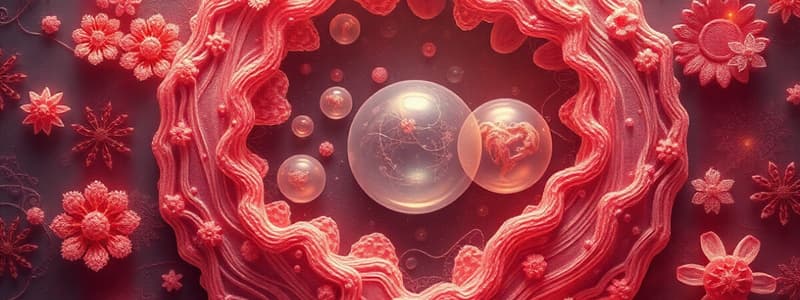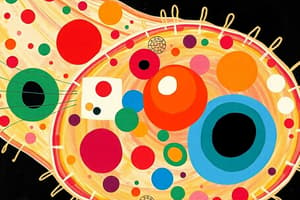Podcast
Questions and Answers
What are the different forms of a gene called?
What are the different forms of a gene called?
- Genotypes
- Alleles (correct)
- Phenotypes
- Heredity
Which process describes the gradual change in characteristics of populations over generations?
Which process describes the gradual change in characteristics of populations over generations?
- Adaptation
- Natural selection
- Speciation
- Evolution (correct)
What is the term for the observable traits of an organism?
What is the term for the observable traits of an organism?
- Allele
- Phenotype (correct)
- Mutation
- Genotype
What does natural selection favor in a population?
What does natural selection favor in a population?
Which classification level comes directly after kingdom in the hierarchical system?
Which classification level comes directly after kingdom in the hierarchical system?
What is the primary function of mitochondria in a cell?
What is the primary function of mitochondria in a cell?
Which cellular process is responsible for producing four genetically unique daughter cells?
Which cellular process is responsible for producing four genetically unique daughter cells?
What is the main role of the endoplasmic reticulum in a eukaryotic cell?
What is the main role of the endoplasmic reticulum in a eukaryotic cell?
Which of the following is NOT a function of proteins in biological systems?
Which of the following is NOT a function of proteins in biological systems?
Which process involves the flow of energy through an ecosystem?
Which process involves the flow of energy through an ecosystem?
Flashcards
Genetics
Genetics
The study of genes, heredity, and variation in living organisms.
Alleles
Alleles
Different forms of a gene.
Adaptation
Adaptation
The process by which organisms become better suited to their environment over time.
Speciation
Speciation
Signup and view all the flashcards
Phenotype
Phenotype
Signup and view all the flashcards
What is a cell?
What is a cell?
Signup and view all the flashcards
What is an organelle?
What is an organelle?
Signup and view all the flashcards
What is cellular respiration?
What is cellular respiration?
Signup and view all the flashcards
What is photosynthesis?
What is photosynthesis?
Signup and view all the flashcards
What is mitosis?
What is mitosis?
Signup and view all the flashcards
Study Notes
Cell Structure and Function
- Cells are the fundamental units of life, responsible for all biological processes.
- Cells exhibit a wide range of sizes and shapes, tailored to their specific functions.
- Prokaryotic cells, like bacteria, lack a nucleus and membrane-bound organelles.
- Eukaryotic cells, found in plants and animals, possess a nucleus and various organelles.
- Organelles are specialized structures within the cell performing specific functions, including mitochondria (energy production), ribosomes (protein synthesis), endoplasmic reticulum (protein and lipid synthesis), golgi apparatus (modifies and packages proteins), and lysosomes (waste disposal).
- The cell membrane acts as a selective barrier, regulating the passage of substances in and out of the cell.
- Cytoplasm is the jelly-like substance filling the cell, holding organelles in place.
- The nucleus houses the cell's genetic material (DNA).
Cell Processes
- Cellular respiration is the process by which cells release energy from food molecules.
- Photosynthesis, occurring in plant cells, converts light energy into chemical energy (sugars).
- Mitosis is the process of cell division for growth and repair in eukaryotic cells, producing two identical daughter cells.
- Meiosis is a specialized type of cell division for sexual reproduction, producing four genetically unique daughter cells.
- DNA replication is the process of copying DNA before cell division to ensure each new cell receives a complete set of genetic instructions.
- Transcription is the process of synthesizing RNA from a DNA template.
- Translation is the process of synthesizing proteins from mRNA templates.
Biological Molecules
- Carbohydrates provide energy and structural support. Monosaccharides are the simplest forms (e.g., glucose).
- Lipids store energy, insulate, and form cell membranes. Examples include fats, phospholipids, and steroids.
- Proteins perform diverse functions, including enzymatic activity, structural support, and transport. Proteins are made up of amino acids.
- Nucleic acids store and transmit genetic information. DNA and RNA are examples.
Ecology
- Ecology is the study of the interactions between organisms and their environment.
- Ecosystems include all living organisms (biotic factors) and their physical environment (abiotic factors).
- Food chains and food webs illustrate the flow of energy through an ecosystem.
- Population dynamics describes the changes in population size and distribution over time.
- Community interactions such as competition, predation, and symbiosis shape ecosystem structure.
- Ecosystem services are the benefits humans derive from healthy ecosystems.
Genetics
- Genetics is the study of genes, heredity, and variation among living organisms.
- Genes are segments of DNA that carry instructions for building proteins.
- Alleles are different forms of a gene.
- Heredity is the passing of traits from parents to offspring through genes.
- Mendel's laws of inheritance describe how genes are passed from one generation to the next.
- Genetic mutations are changes in DNA sequence.
- Genotypes are the genetic makeup of an organism.
- Phenotypes are the observable traits of an organism.
Evolution
- Evolution is the process of gradual change in the characteristics of populations over many generations.
- Natural selection is a key mechanism of evolution, where organisms with advantageous traits are more likely to survive and reproduce.
- Adaptation is the process by which organisms become better suited to their environment.
- Speciation is the formation of new species from existing ones.
- Common ancestry links all living organisms.
- Phylogenetic trees illustrate evolutionary relationships among species.
Classification of Organisms
- Organisms are categorized using a hierarchical system (domain, kingdom, phylum, class, order, family, genus, species).
- Species are groups of organisms that can interbreed and produce fertile offspring.
- Taxonomic classification reflects evolutionary relationships.
Studying That Suits You
Use AI to generate personalized quizzes and flashcards to suit your learning preferences.




